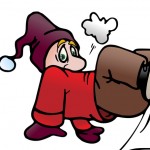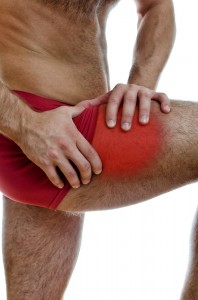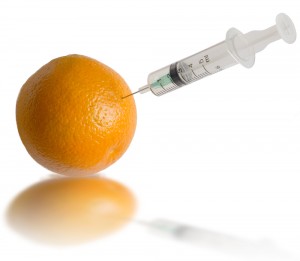
During last winter several elves slipped on ice and landed heavily. Although initially embarrassed, most forgot the incident but a few still struggle with lateral hip pain when climbing stairs or sleeping in bed.
 Previously known as trochanteric bursitis, this condition is now defined as Greater Trochanteric Pain Syndrome (GTPS). This umbrella term covers a range of disorders such as enthesiopathy, muscle tears, and soft tissue dysfunctions causing pain on the outside of the hip. It is not always associated with trauma; abnormal hip biomechanics, osteoarthritis, obesity and specific sporting activities can contribute to GTPS. Affecting 10-25% of the population, rising to 35% where leg length discrepancy is present and more prevalent in women aged between 40 -60 years, it can be a debilitating condition. This review reported the outcomes of patients undergoing conservative or surgical management of GTPS.
Previously known as trochanteric bursitis, this condition is now defined as Greater Trochanteric Pain Syndrome (GTPS). This umbrella term covers a range of disorders such as enthesiopathy, muscle tears, and soft tissue dysfunctions causing pain on the outside of the hip. It is not always associated with trauma; abnormal hip biomechanics, osteoarthritis, obesity and specific sporting activities can contribute to GTPS. Affecting 10-25% of the population, rising to 35% where leg length discrepancy is present and more prevalent in women aged between 40 -60 years, it can be a debilitating condition. This review reported the outcomes of patients undergoing conservative or surgical management of GTPS.
Here’s what they did
They searched databases from inception to June 2011 for studies published in English, Spanish, French and Italian reporting clinical, functional and imaging outcomes for patients managed for GTPS. Outcomes and success rates for interventions were extracted and methodological quality was evaluated using the Coleman Methodology Score (CMS) (Coleman et al. 2000).
Here’s what they found
Fifty two potential studies were identified and 14 included. Conservative interventions included; corticosteroid injection, home training exercises and shock wave therapy (SWT). Surgical interventions were; open surgical procedures, open gluteal repair, arthroscopy, and endoscopic gluteal repair. Outcome measures reported in studies were Harris Hip Score, VAS, Likert Scale and Merle d’Auberge scale. Statistical assessment was not possible due to heterogeneous and poorly reported data.

- Corticosteroid injection provided short term results compared with SWT and home training exercise at one month, but at 15 months both SWT and home exercise were significantly more successful than steroid injection.
- Good results were reported after open and closed surgical procedures but study numbers were small and results difficult to compare and interpret.
- Relative difference between home training and SWT was not significant in the long term.
The authors concluded
The optimal management for GTPS was unclear. Given the wide variety of isolated and concomitant disorders involved, focus on pre-treatment diagnosis is essential. They recommended:
“Further investigation should focus on subjects with acute presentation to ascertain whether a wait-and-see policy leads to results comparable with home training.”
The Musculoskeletal Elf’s view
 Unfortunately the small sample sizes in the included studies reduce the strength of findings for surgical management, and the application of different outcome measures across studies made comparison of results difficult. However, the findings of only short term improvement with corticosteroid injection correlate with another recent systematic review examining efficacy of these injections in the management of tendinopathy (Coombes et al. 2010). The MSK Elf agrees with the authors that recent advances in understanding pain mechanisms and chronic tendinopathy may result in different approaches to the management of GTPS in the future.
Unfortunately the small sample sizes in the included studies reduce the strength of findings for surgical management, and the application of different outcome measures across studies made comparison of results difficult. However, the findings of only short term improvement with corticosteroid injection correlate with another recent systematic review examining efficacy of these injections in the management of tendinopathy (Coombes et al. 2010). The MSK Elf agrees with the authors that recent advances in understanding pain mechanisms and chronic tendinopathy may result in different approaches to the management of GTPS in the future.
Questions….
- Do these findings correlate to your experience of GTPS?
- What approaches have you found beneficial in the management of this condition?
- Have you used a pain management approach with chronic GTPS?
- Send us your views on this blog and become part of the Musculoskeletal Elf community.
Links
- Del Buono A, Papalia R, Khanduja V, Denaro V, Maffulli N. Management of the greater trochanteric pain syndrome: a systematic review Br Med Bull. 2012 Jun;102:115-31. Epub 2011 Sep 4.
- Coombes B K, Bisset L, Vicenzino B, 2010, Efficacy and safety of corticosteroid injections and other injections for management of tendinopathy: a systematic review of randomised controlled trials, The Lancet, Volume 376, Issue 9754, pp 1751 – 1767
- Coleman BD, Khan KM, Maffulli n et al. 2000 Studies of surgical outcome after patella tendinopathy:clinical significance of methodological deficiencies and guidelines for future studies. Scandinavian Journal of Medicine & Science in Sports, 10(1) pp2-11

I find this a common condition often overlooked. I have also found some success with soft tissue work or dry needling of the ipsilateral glutei, gluteus and hamstring stretches and a thorough examination of any sporting/ leisure/ergonomic factors (often dont find any). Causative factors I find illusive and I have no real evidence base apart from the dreaded “in my experience.” Nice article – thanks.
Thanks Keith, this a tricky condition to manage probably due to number of different problems and structures that are encompassed by the umbrella term of GTPS. Unfortunately soft tissue work was not an intervention identified in this article, but like you I have found ‘in my experience’ it can be helpful with certain presentations. Thanks for your post, Lesley.
I agree with Keith, soft tissue work can be very effective with this. There is some work by Alison Grimaldi which looks at tendinopathy a major contributing factor to this. Again it tends to follow Cook and Purdams model of tendinopathy.
As far as causative factors go – Compression seems to be a factor – people sitting cross-legged compressing the GM tendon, or knees and hips internally rotated, also those that sit in low seats, hips below knees. It also has a higher rate of incidence in diabetics, those that carry their fat round their waste and females over 40 (all this info from work I saw from A.Grimaldi and J.Cook). They suggest modifying sitting positions, eccentric loading for GM, soft tissue work and glute control work – and also no stretching of ITB (if its possible) or clam ex’s as they also will compress the area.
Hope that brings something to the table. Thanks for the article Lesley.
Alan